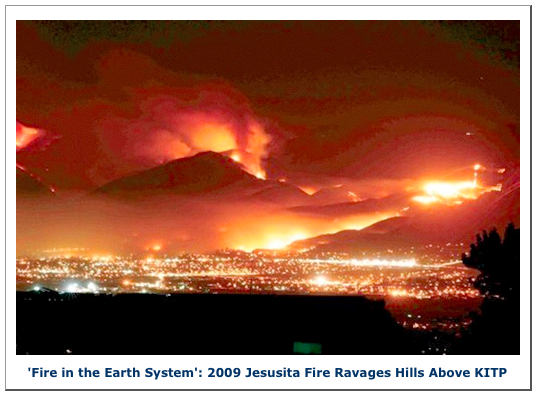To gain access to the Bodleian Library at Oxford University, David Bowman, professor of forest ecology at the University of Tasmania, had to sign a pledge that he would not use a candle in the facility that dates back to 1602, a time when readers could readily be suspected of lighting up. The anachronistic pledge was not particular to Bowman; anybody seeking access has so to sign. But few could appreciate its significance as much as Bowman, who is an expert on fire ecology and the lead author on a recently published paper in Science, which argues that the spectacular wildfires (in Australia or California or France or Greece or South Africa that periodically erupt into the news) represent a singular global phenomenon particularly relevant to climate change.
That article, "Fire in the Earth System," states that,"…though the Intergovernmental Panel on Climate Change (IPCC) report concluded that global climate change will increase the risk of extreme fire events, its assessment did not quantify potential fire-climate feedbacks." The article’s sustained argument for a dynamic global perspective concludes: "Indeed, future IPCC assessment of anthropogenic global climate forcing should include specific analyses of the role of fire." In other words, fire is to be considered not only as a consequence of global warming, but also causal in the inexorable chain reaction of a positive feedback mechanism.
The article was written at the KITP by a working group focusing on fire ecology in conjunction with the program "Physics of Climate Change." The animating force for both the workshop and the article came from Bowman and Jennifer Balch, a postdoctoral fellow at the National Center for Ecological Analysis and Synthesis (NCEAS).
The workshop itself represented a first-time-ever joint effort between KITP and NCEAS, both located at the University of California at Santa Barbara (UCSB) and both funded by the National Science Foundation (NSF). The article’s 22 authors were workshop participants or "Climate Change" program organizers, including Brad Marston, principal program organizer, and Jean Carlson, UCSB physicist and expert on fire modeling who acted as principal liaison in the innovative research collaboration between physicists and ecologists that led to the published insights.
The authors note that, "there remains a serious lack of knowledge about fire’s fundamental role in Earth System processes, as well as an insufficient appreciation of fire’s interaction with anthropogenic global environmental change."
Bowman unpacks the implications of that coolly scientific observation by conjuring a hypothetical scenario featuring insurance industry risk assessment experts wondering how to lower exposure to losses due to fire. "Let’s say," said Bowman, "that the insurance industry decide to ask the experts on fire ecology, ‘How would you fix the problem?’ All I can say is ‘I have absolutely no idea!’ What we are saying in this article is that we don’t have a theory. We have only just realized these wildfires represent a global syndrome—that we are seeing a commonality of process worldwide."
Wildfires Global
 Before the KITP workshop, said Bowman, "Nobody had thought to think about fire in this holistic way. Look at the IPCC report, the gold standard for understanding global climate change [recognized with the 2007 Nobel Peace Prize]; there is no chapter on biomass burning."
Before the KITP workshop, said Bowman, "Nobody had thought to think about fire in this holistic way. Look at the IPCC report, the gold standard for understanding global climate change [recognized with the 2007 Nobel Peace Prize]; there is no chapter on biomass burning."
The holistic perspective, advocated in the article, includes not only the current global context for fire as the climate changes, but also the historic and geological one that emphasizes the long human development affected by its use, as well as its shaping agency in terms of the evolution of habitats.
"Fire is a worldwide phenomenon that appears in the geological record soon after the appearance of terrestrial plants," begins the article. "Fire influences global ecosystem patterns and processes including vegetation distribution and structure, the carbon cycle, and climate. Although humans and fire always have coexisted, our capacity to manage fire remains imperfect and may become more difficult in the future as climate change alters fire regimes."
With respect to insurance industry concerns about burning structures, Bowman said, "The urban-woodland interface presents an intractable problem. We’ve got a lot of infrastructure in the wrong places."
Balch said, "Global warming appears to be changing the windows of opportunity for extreme fire events," and by "changing the windows," she means expanding fire season and fire size in fire-prone regions though data exist to support that contention mostly for California where, she said. "Increasing temperature is a major predictor of increasing fire occurrence and size."
Bowman and Balch agree that the insights of their published paper now seem "obvious," yet had been impeded by a strong regional bias characteristic of their discipline and understandable in a scientific endeavor such as ecology that ties the investigator to the natural habitat that he or she studies.
"The key word is ‘theory,’" said Bowman. "We held this workshop at a theoretical physics institute. Ecologists are strongly phenomenological and pragmatic." In the environment of theoretical physics, he said, "we began to think of fire more abstractly in terms of models and equations"—in effect, "globally."
